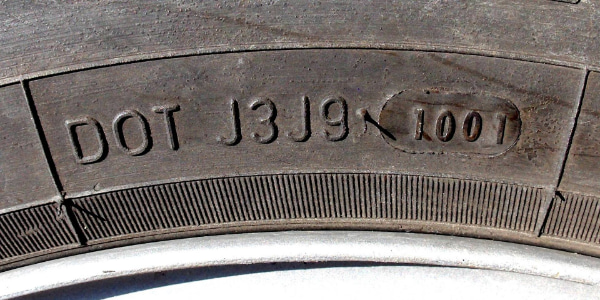The Science Behind Tire Aging: When Should You Really Replace Your Tires?
Posted by BB Wheels on 14th Nov 2023

The Science Behind Tire Aging: When Should You Really Replace Your Tires?
When it comes to vehicle maintenance, tire health is paramount. But while many drivers are vigilant about tire pressure and tread depth, tire aging is often overlooked. Understanding the science behind tire aging is crucial for safety, performance, and cost-effectiveness. In this post, we'll explore how to spot signs of wear and determine when it's time for a replacement.
What Causes Tire Aging?
Tires age due to a combination of factors, including:
- Exposure to Elements: UV rays from the sun and ozone in the air gradually degrade the rubber compounds in tires, leading to cracks and brittleness.
- Temperature Fluctuations: Extreme temperatures, both hot and cold, can accelerate the aging process.
- Usage Patterns: Infrequent use or long periods of stationary storage can cause tires to age differently, often leading to flat spots and dry rot.
- Road Conditions: Frequent exposure to rough roads can increase wear and tear.
How to Spot Signs of Tire Aging
- Cracks in the Sidewall: Look for small cracks or cuts in the sidewall. These are often the first visible signs of aging.
- Tread Wear: While tread depth is commonly checked, uneven wear can also indicate aging issues.
- Bulges or Blisters: These can form on the tire’s surface as the internal structure breaks down.
- Vibration or Ride Comfort: Changes in how your vehicle handles or excessive vibration can be symptoms of aging tires.
When to Replace Your Tires
The general rule of thumb is to replace tires every 6 to 10 years, regardless of tread life. However, this can vary based on the manufacturer's recommendations, usage patterns, and environmental conditions. Here are some guidelines:
- Regular Inspections: Have your tires inspected annually after the fifth year.
- Manufacturer Date: Check the tire’s sidewall for the DOT code, which includes the week and year of manufacture. This can guide you on the tire's age.
- Performance Checks: If you notice any decline in performance, such as grip or handling, it might be time for a replacement.
- Professional Advice: When in doubt, consult with a tire professional who can assess the condition of your tires.
How to Determine the Age of Your Tires
Knowing the age of your tires is essential in assessing their condition and deciding when they should be replaced. The age of a tire can be determined by reading the DOT (Department of Transportation) code on the sidewall.
Locating the DOT Code
Find the DOT Code: Look on the sidewall of the tire for a code that begins with "DOT." This code indicates that the tire complies with all federal standards and provides valuable information about the tire's manufacture date.
Read the Last Four Digits: The DOT code ends with a series of numbers. The last four digits of this series are what you need to determine the tire's age.
Example:
- A tire with a DOT code ending in "2318" was manufactured in the 23rd week of 2018.
- A tire with a DOT code ending in "1120" was manufactured in the 11th week of 2020.

Image Description: The image above shows a close-up of a tire sidewall with a DOT code reading "1001." This indicates that the tire was manufactured in the 10th week of the year 2001. Understanding this code is essential for assessing tire age and making informed decisions about tire replacement.
Preventing Premature Tire Aging
- Proper Storage: Keep tires in a cool, dry place away from direct sunlight and ozone sources to prevent degradation.
- Regular Use: Regularly driving your vehicle helps prevent issues like flat spots and dry rot associated with long-term parking.
- Maintain Proper Inflation: Consistently check and maintain tire pressure according to the manufacturer's recommendations to avoid accelerated wear and aging.
- Avoid Harsh Conditions: Limit exposure to extreme temperatures and harsh sunlight. Using a garage or carport can significantly reduce UV and heat exposure.
- Rotate Tires Regularly: Regular rotation ensures even wear and can extend the life of your tires.
Making the Right Choice for Replacement
When it's time to replace your tires, consider the following:
- Choose the Right Tire: Ensure the new tires are a good fit for your vehicle and driving needs. At BB Wheels, we offer a wide range of options for different vehicles and driving conditions.
- Quality Matters: Invest in high-quality tires from reputable manufacturers. They might cost more upfront but tend to last longer and perform better, offering better value in the long run.
- Online Convenience: As an online retailer, BB Wheels provides the convenience of choosing the right tires from the comfort of your home. We offer detailed descriptions and expert advice to help you make an informed decision.
Summary
Understanding tire aging and knowing when to replace your tires is crucial for safe and efficient driving. Regular inspections, being aware of aging signs, and following manufacturer guidelines are key to ensuring your vehicle remains in top condition. When it's time for new tires, BB Wheels is here to assist you in finding the perfect match for your vehicle and driving needs. Remember, investing in your tires is investing in your safety on the road.
If you have any questions or need expert advice on choosing the right tires, don't hesitate to reach out to us. Our team of professionals is ready to provide you with personalized assistance to ensure you make the best choice for your vehicle. Call us at 320-333-2155 for guidance and support.
Stay safe and enjoy the ride!

